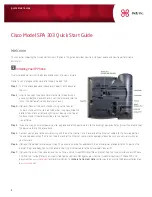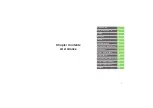
[ 86 ]
Reference information
Emergency calls
Important:
This phone, like any
wireless phone, operates using
radio signals, wireless, and
landline networks as well as
user-programmed functions.
Because of this, connections in
all conditions cannot be
guaranteed. Therefore you
should never rely solely upon any
wireless phone for essential
communications (for example,
medical emergencies).
Emergency calls may not be possible on
all wireless phone networks or when
certain network services and/or phone
features are in use. Check with local
service providers.
Make an Emergency Call
1
If the phone is not on, switch it on.
2
Press the
End key
as many times as
needed (for example, to exit a call, to
exit a menu, etc.) to clear the display
and ready the phone for calls.
3
Enter the emergency number for your
present location (for example, 911 or
any other official emergency number—
emergency numbers vary by location).
4
Press the
Send key
.
• If certain features are in use, you may
first need to turn those features off
before you can make an emergency
call. Consult this user guide and your
local cellular service provider.
• When making an emergency call,
remember to give all the necessary
information as accurately as possible.
Remember that your wireless phone
may be the only means of
communication at the scene of an
accident - do not end the call until
given permission to do so.
• CERTIFICATION
INFORMATION (SAR)
THIS MODEL PHONE MEETS
GOVERNMENT REQUIREMENTS FOR
EXPOSURE TO RADIO WAVES
Your mobile phone is a radio transmitter
and receiver. It is designed and
manufactured not to exceed the limits
for exposure to radio frequency (RF)
energy set by the Australian
Communications Authority (ACA). These
limits are part of comprehensive
guidelines and establish permitted levels
of RF energy for the general population.
The guidelines are based on standards
that were developed by independent
scientific organisations through periodic
and thorough evaluation of scientific
studies. The guidelines include a
substantial safety margin designed to
assure the safety of all persons,
regardless of age and health.
The exposure standard for mobile phones
employs a unit of measurement known as
the Specific Absorption Rate, or SAR. The
SAR limit set by the ACA is 1.6 W/kg*.
Tests for SAR are conducted using
standard operating positions with the
phone transmitting at its highest
certified power level in all tested
frequency bands. Although the SAR is
determined at the highest certified
power level, the actual SAR of the phone
while operating can be well below the
maximum value. This is because the
phone is designed to operate at multiple
power levels so as to use only the power
required to reach the network. In general,
the closer you are to a base station, the
lower the power output of the phone.
En3586.book Page 86 Wednesday, April 30, 2003 7:05 PM
















































